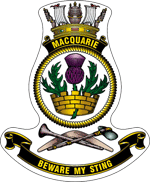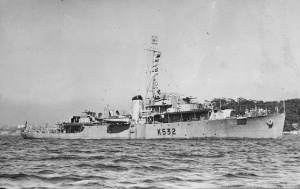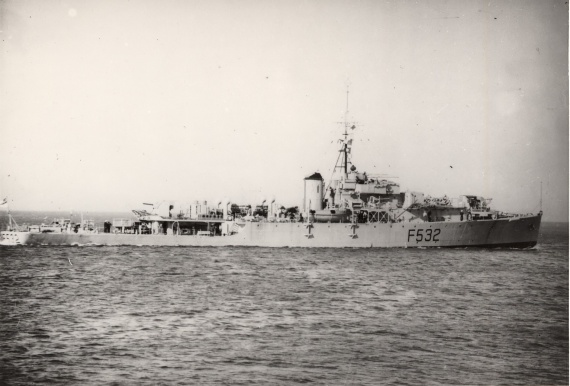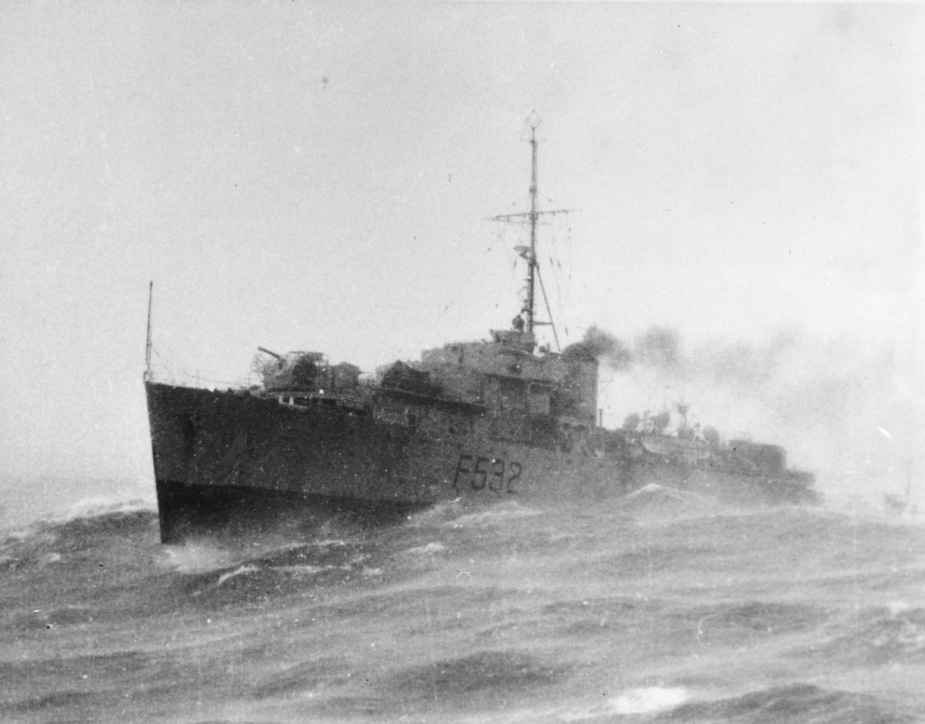HMAS Macquarie
| Class |
River Class |
|---|---|
| Type |
Frigate |
| Pennant |
K532 |
| Builder |
Mort's Dock & Engineering Co Ltd, Sydney |
| Laid Down |
3 December 1943 |
| Launched |
3 March 1945 |
| Launched by |
Mrs Fraser, wife of a Senator for Western Australia |
| Commissioned |
7 December 1945 |
| Decommissioned |
17 March 1954 |
| Dimensions & Displacement | |
| Displacement |
|
| Length | 301 feet 6 inches |
| Beam | 36 feet 8 inches |
| Draught | 12 feet |
| Performance | |
| Speed | 20 knots |
| Complement | |
| Crew | 140 |
| Propulsion | |
| Machinery | Triple Expansion, 2 Shafts |
| Horsepower | 5,500 |
| Armament | |
| Guns |
|
| Other Armament |
|

HMAS Macquarie was ordered as part of Australia's shipbuilding program during the Second World War. Twelve of these Australian built frigates were to enter service with the Royal Australian Navy. A further ten were ordered but cancelled as the war drew to a close.
Eight, HMA Ships Barcoo, Barwon, Burdekin, Diamantina (I), Gascoyne (I), Hawkesbury, Lachlan and Macquarie, were built to the British River Class design and Australia likewise named its frigates after Australian rivers. A further four, HMA Ships Condamine (I), Culgoa, Murchison and Shoalhaven, were also named after Australian rivers but were built to the design of the Royal Navy's Bay Class Frigates. These latter ships were generally known as Modified River Class Frigates although they are sometimes referred to as Bay Class.
Macquarie commissioned at Sydney on 7 December 1945 under the command of Lieutenant Commander Leslie M Hinchliffe DSC RAN.
After completing her working up programme, Macquarie sailed from Sydney on 31 January 1946 to commence three months service in New Guinea waters, including one month in Rabaul. During this time she undertook the salvage of the wrecked Japanese tanker Naruto at Karavia Bay.
Returning to Sydney on 29 April 1946, Macquarie spent seven weeks alongside before sailing on 15 June 1946 for Indonesia. She visited Batavia and Padang and during her service in Indonesian waters, Macquarie assisted the War Crimes Investigation and Graves Registration teams.
Macquarie returned to Sydney on 22 October 1946, having proceeded via Darwin and Townsville. She arrived in Melbourne on 27 October, where she paid off into E Class Reserve on 19 December 1946 after only one year of seagoing service and having steamed 20,074 miles.
After almost six years in Reserve, Macquarie recommissioned at Melbourne on 15 August 1952 under the command of Lieutenant Commander Arthur I Chapman RAN
After working up, Macquarie paid a brief visit to Port Moresby en route to Darwin and the Monte Bello Islands, where she conducted surveillance activities and duties as the weather support ship for the first British atomic test which took place at Monte Bello on 3 October 1952.
Macquarie returned to the Australian east coast late October, operating in east coast waters until April 1953. During this month she deployed to Darwin. She was based at Darwin from 24 April to 8 September. This period included a three month stint in the waters off Darwin carrying out surveillance of the Japanese Pearling Fleet.
Macquarie returned to Sydney on 19 September 1953 and paid off into Reserve on 17 March 1954. During her second commission, Macquarie steamed a further 31,146 miles for a combined total over both commissions of 51,220 miles. She was sold to be broken up as scrap on 5 July 1962 to HC Sleigh & Co for Mitsubishi (Australia) Pty Ltd.





